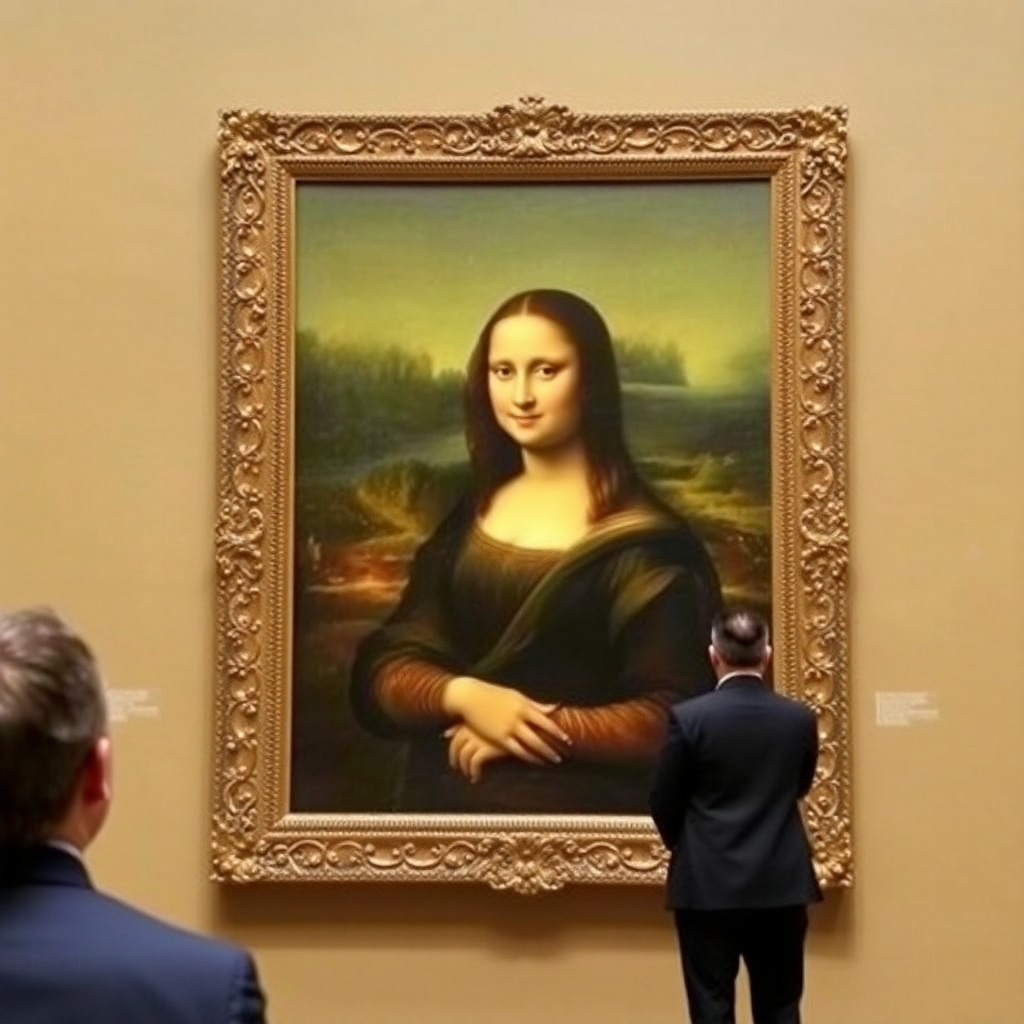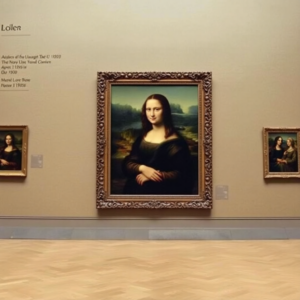Introduction: A New Chapter for the Mona Lisa
The Mona Lisa, painted by Leonardo da Vinci in the early 16th century, remains one of the most iconic and recognizable works of art in history. For centuries, this enigmatic masterpiece, famous for its mysterious smile and detailed brushwork, has captured the imagination of art lovers worldwide. Housed in the Louvre Museum in Paris since the French Revolution, it has been a cornerstone of the museum’s vast collection and a must-see attraction for millions of visitors every year.
However, despite its unmatched cultural significance, the Mona Lisa’s display conditions have been a subject of debate. For years, it has been exhibited in the Salle des États, a large gallery within the Louvre that houses other masterpieces. While this setting allowed it to coexist with other celebrated artworks, it also created significant challenges, including overcrowding, logistical issues, and preservation concerns. The growing influx of visitors—over 10 million annually—has made it increasingly difficult to provide a comfortable and enriching experience for everyone.
In January 2025, the Louvre announced a groundbreaking initiative: the Mona Lisa would be relocated to a dedicated gallery as part of the museum’s extensive “New Renaissance” renovation project. This decision aims to address longstanding issues while redefining how visitors engage with the world’s most famous painting. By creating a space solely for the Mona Lisa, the Louvre seeks to enhance the visitor experience, ensure the artwork’s long-term preservation, and showcase its historical and cultural importance in a more meaningful way.
The move signifies a turning point in the museum’s history. For the first time, the Mona Lisa will have a gallery tailored specifically to its needs, offering an immersive environment that celebrates its legacy. The new gallery is expected to set a benchmark for how iconic works of art are displayed in the modern era.
The “New Renaissance” Initiative: Revitalizing the Louvre
The Mona Lisa’s relocation is part of the Louvre’s larger “New Renaissance” initiative, a comprehensive renovation project aimed at modernizing the museum and addressing the challenges of contemporary museum management. This ambitious undertaking, with a budget of over €700 million, reflects the Louvre’s commitment to innovation, sustainability, and cultural accessibility.
The “New Renaissance” project addresses several key issues faced by the Louvre, including overcrowding, limited accessibility, and the need for sustainable practices. With the museum receiving an average of 10 million visitors annually, the current infrastructure has struggled to accommodate the sheer volume of people. Long queues, crowded galleries, and logistical bottlenecks have become common complaints among visitors. The Mona Lisa, as the museum’s star attraction, often experiences the brunt of these issues, leading to a less-than-ideal experience for those hoping to admire the painting up close.
To address these concerns, the “New Renaissance” initiative focuses on redistributing visitor traffic and creating a more balanced flow throughout the museum. This includes constructing new entrances, expanding exhibition spaces, and renovating existing galleries. The creation of a dedicated gallery for the Mona Lisa is one of the most significant elements of this plan, as it allows the museum to alleviate congestion in the Salle des États while giving the painting a more prominent and spacious setting.
Sustainability is another cornerstone of the project. The Louvre has pledged to reduce its environmental footprint by incorporating energy-efficient technologies and eco-friendly materials into its renovations. These measures align with global efforts to make cultural institutions more sustainable while preserving their historical integrity.
Funding for the “New Renaissance” initiative comes from a combination of public and private sources. The French government, corporate sponsors, and international donors have all contributed to the project. In addition, the Louvre has launched public fundraising campaigns to engage art enthusiasts and supporters worldwide.
The project is being carefully managed to minimize disruptions to the museum’s operations. While certain sections of the Louvre will be temporarily closed during renovations, the majority of its collection will remain accessible to visitors. This ensures that the museum continues to serve as a vibrant cultural destination throughout the process.
Why the Mona Lisa Needed a Dedicated Gallery
The decision to give the Mona Lisa its own gallery was driven by several important factors. Chief among them is the issue of overcrowding in the Salle des États. The painting’s immense popularity often results in large crowds gathering around it, creating a challenging environment for both visitors and museum staff. This not only diminishes the viewing experience but also raises concerns about safety and accessibility.
By relocating the Mona Lisa to a dedicated gallery, the Louvre can provide a more comfortable and intimate setting for visitors. The new gallery will be designed to accommodate larger groups while maintaining a sense of exclusivity and tranquility. Advanced crowd management systems will be implemented to ensure a smooth and enjoyable experience for everyone.
Another critical factor is the preservation of the painting itself. The Mona Lisa, painted on a delicate poplar wood panel, is highly sensitive to environmental conditions such as humidity, temperature, and light. While the current display includes protective measures, a dedicated gallery will allow the Louvre to implement state-of-the-art preservation technologies specifically tailored to the artwork’s needs. This will help ensure that the painting remains in optimal condition for future generations.
The new gallery will also provide an opportunity to deepen visitors’ understanding of the Mona Lisa. In addition to the painting itself, the space will feature exhibits exploring its history, artistic techniques, and cultural impact. Visitors will be able to learn about Leonardo da Vinci’s life and work, the painting’s journey from Italy to France, and the reasons behind its enduring popularity. This contextual approach aims to enrich the viewing experience and foster a deeper appreciation for the masterpiece.
The relocation aligns with the Louvre’s broader mission to innovate and adapt to modern challenges. As museums worldwide grapple with issues such as overcrowding and evolving audience expectations, the Louvre’s decision sets an example for how cultural institutions can reimagine the presentation of their collections.
Designing the Mona Lisa’s New Gallery
The dedicated gallery for the Mona Lisa will be a state-of-the-art space, carefully designed to showcase the painting in all its glory. Every aspect of the gallery, from its layout to its lighting, will be tailored to enhance the visitor experience and preserve the artwork.
The gallery will feature a minimalist design, allowing the Mona Lisa to take center stage. Visitors will enter through a carefully curated pathway that gradually builds anticipation, culminating in a dramatic unveiling of the painting. The room will be spacious enough to accommodate large crowds while maintaining a sense of intimacy.
Advanced climate control systems will ensure that the painting is displayed in optimal environmental conditions. These systems will regulate temperature, humidity, and air quality to protect the delicate poplar wood panel from deterioration. Anti-reflective glass and adjustable lighting will be used to minimize glare and enhance visibility, allowing visitors to appreciate the painting’s intricate details.
Interactive displays and multimedia installations will provide additional context about the Mona Lisa. These features will explore topics such as Leonardo da Vinci’s artistic techniques, the painting’s symbolism, and its influence on popular culture. By combining traditional and digital elements, the gallery aims to engage visitors of all ages and backgrounds.
The space will also include seating areas and designated zones for guided tours, ensuring that everyone can enjoy the painting at their own pace. Accessibility features such as ramps, elevators, and multilingual signage will make the gallery inclusive for all visitors.
The gallery’s design reflects the Louvre’s commitment to creating a world-class cultural experience. By combining innovation, sustainability, and artistic excellence, the museum aims to set a new standard for how iconic artworks are displayed.
Impact on the Art World and Beyond
The decision to relocate the Mona Lisa to a dedicated gallery has generated widespread excitement and anticipation within the global art community. Experts and enthusiasts alike have praised the move as a forward-thinking approach to art curation and museum management.
The new gallery is expected to enhance the Mona Lisa’s already immense cultural significance. By providing a more immersive and educational experience, the Louvre hopes to deepen visitors’ connection to the painting and inspire a greater appreciation for its artistic and historical context.
The relocation also has broader implications for the art world. As museums around the globe face challenges such as overcrowding, limited resources, and shifting audience expectations, the Louvre’s initiative serves as a model for how institutions can adapt and innovate. By prioritizing the needs of both visitors and artworks, the museum is demonstrating a commitment to excellence and sustainability.
The Mona Lisa’s dedicated gallery is likely to attract even more visitors to the Louvre, further solidifying its status as a premier cultural destination. The move is expected to have a positive economic impact as well, boosting tourism and generating revenue for the museum and the city of Paris.
Beyond the art world, the decision to relocate the Mona Lisa reflects a broader societal trend toward reimagining how cultural heritage is presented and preserved. In an era of rapid change and technological advancement, institutions like the Louvre are embracing new strategies to remain relevant and accessible.
A Historic Moment for the Louvre
The Mona Lisa’s move to a dedicated gallery marks a turning point in the history of the Louvre and the art world. This decision reflects the museum’s commitment to innovation, preservation, and accessibility, ensuring that the world’s most famous painting remains a source of inspiration for generations to come.
As preparations for the relocation continue, the global art community eagerly awaits the unveiling of the new gallery. This transformative project not only enhances the Mona Lisa’s legacy but also sets a new benchmark for how iconic works of art are displayed and celebrated. The Louvre’s “New Renaissance” initiative serves as a reminder of the enduring power of art to captivate, educate, and inspire.
Feel free to check out our other website at : https://scoremaxed.com/













